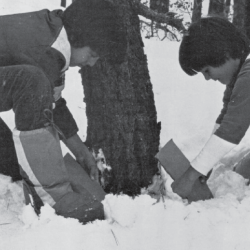Source Institutions
Source Institutions
Add to list Go to activity
Activity link broken? See if it's at the internet archive

In this outdoor, winter activity, learners find living green plants under the snow and determine the light and temperature conditions around the plants. Then, they find out how the snow layer affects the temperature around plants under the snow. An extension of this activity is to bury half of a supply of juicy fruit samples in snow, and leave the other half on the surface. When the surface fruit samples are partially frozen, learners can compare the number of frozen sections in the under-snow samples vs. the above-snow samples.
- 30 to 45 minutes
- 30 to 45 minutes
- Over $20 per group of students
- Ages 8 - 18
- Activity, Experiment/Lab Activity, Lesson/Lesson Plan
- English
Quick Guide
Materials List (per group of students)
- 8.5" x 11" black construction paper
- small letter envelopes (3.5" x 6.5", preferably brown)
- strips of proof paper, 2 cm x 6 cm
- tape or stapler
- paper clips
- small jars
- pencils
- photographic hypo solution (fixing solution)
- water
- meter sticks or dowels with a centimeter scale
- rolls of plastic electrician's tape, shipping tape, or duct tape
- small (6 oz.) metal juice cans
- small (6 oz.) cardboard juice cans
- one-meter lengths of brightly colored string
- Celcius thermometers
- rubber bands
- trowels
- pieces of triwall cardboard, 40 cm x 40 cm
- small jars of water
- tweezers
- pencils
- rulers
- watches with second hand
- data board or large drawing pad
- felt-tip marking pens
- 2 rolls of transparent tape
- Making a Light Reading Technique Card (page 5 and 6 of PDF)
- Thermometer Dip-Stick Equipment Card (page 7 of PDF)
Subjects
-
Earth and Space Science
-
Earth Processes
- Weather and Climate
-
Earth Processes
-
Life Sciences
-
Diversity of Life
- Plants
- Ecology
-
Diversity of Life
-
Mathematics
-
Data Analysis and Probability
- Data Collection
- Data Representation
- Measurement
-
Data Analysis and Probability
-
Physical Sciences
-
Heat and Thermodynamics
- Heat and Temperature
-
Vibration and Waves
- Light and Optics
-
Light and Optics
- Sunlight and Color
-
Heat and Thermodynamics
-
The Nature of Science
-
The Scientific Process
- Asking Questions
- Conducting Investigations
- Gathering Data
- Formulating Explanations
- Communicating Results
-
The Scientific Process
Informal Categories
- Food and Cooking
- Nature and Environment
- Outdoor Activity
- Physical Activity
Audience
To use this activity, learners need to:
- see
- see color
- read
- be mobile
- touch
Learning styles supported:
- Involves teamwork and communication skills
- Involves hands-on or lab activities
Other
This resource is part of:
Access Rights:
- Free access
By:
Rights:
- All rights reserved, The Regents of the University of California, 1982
